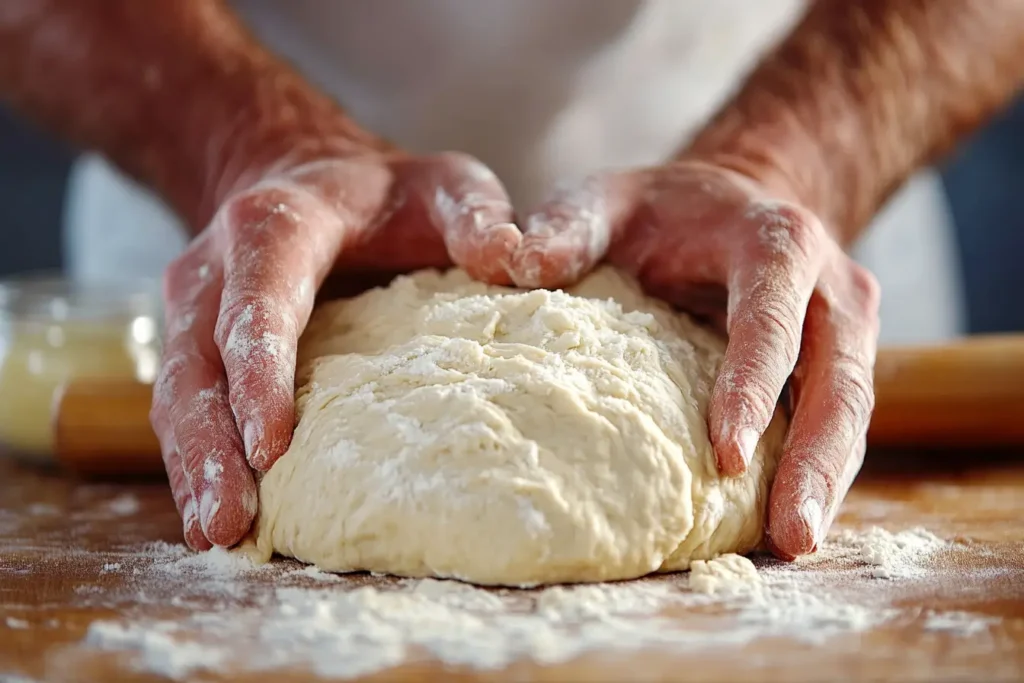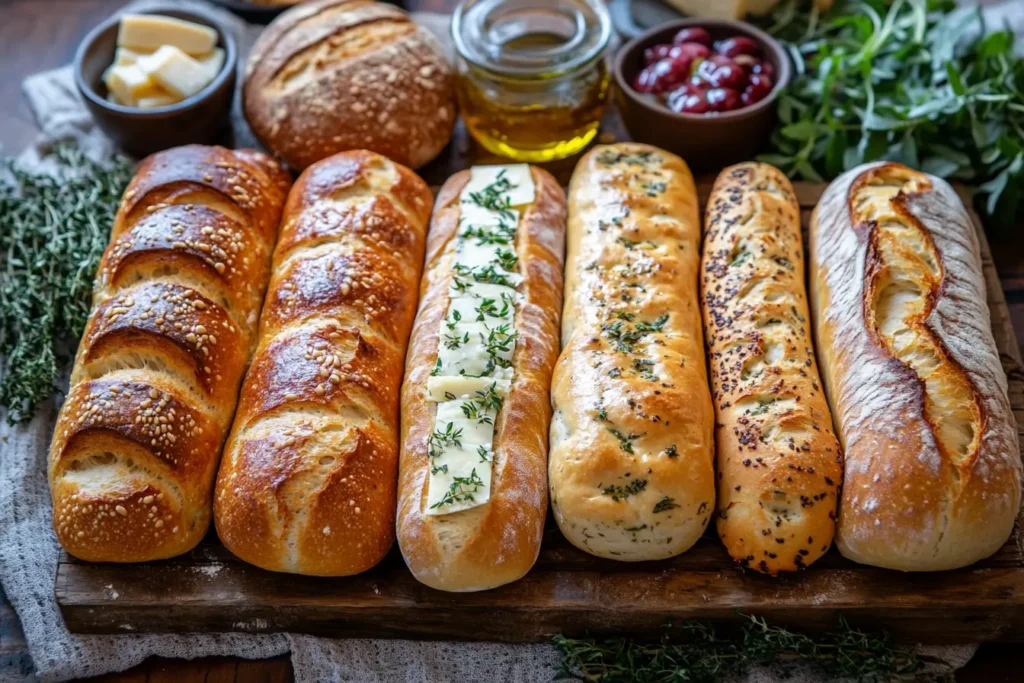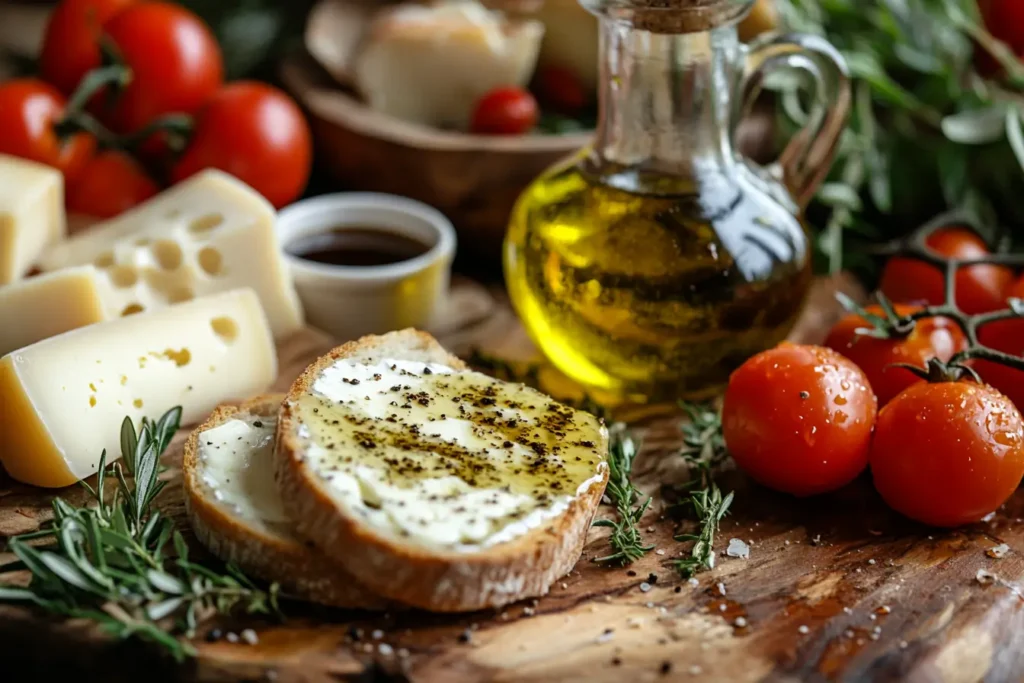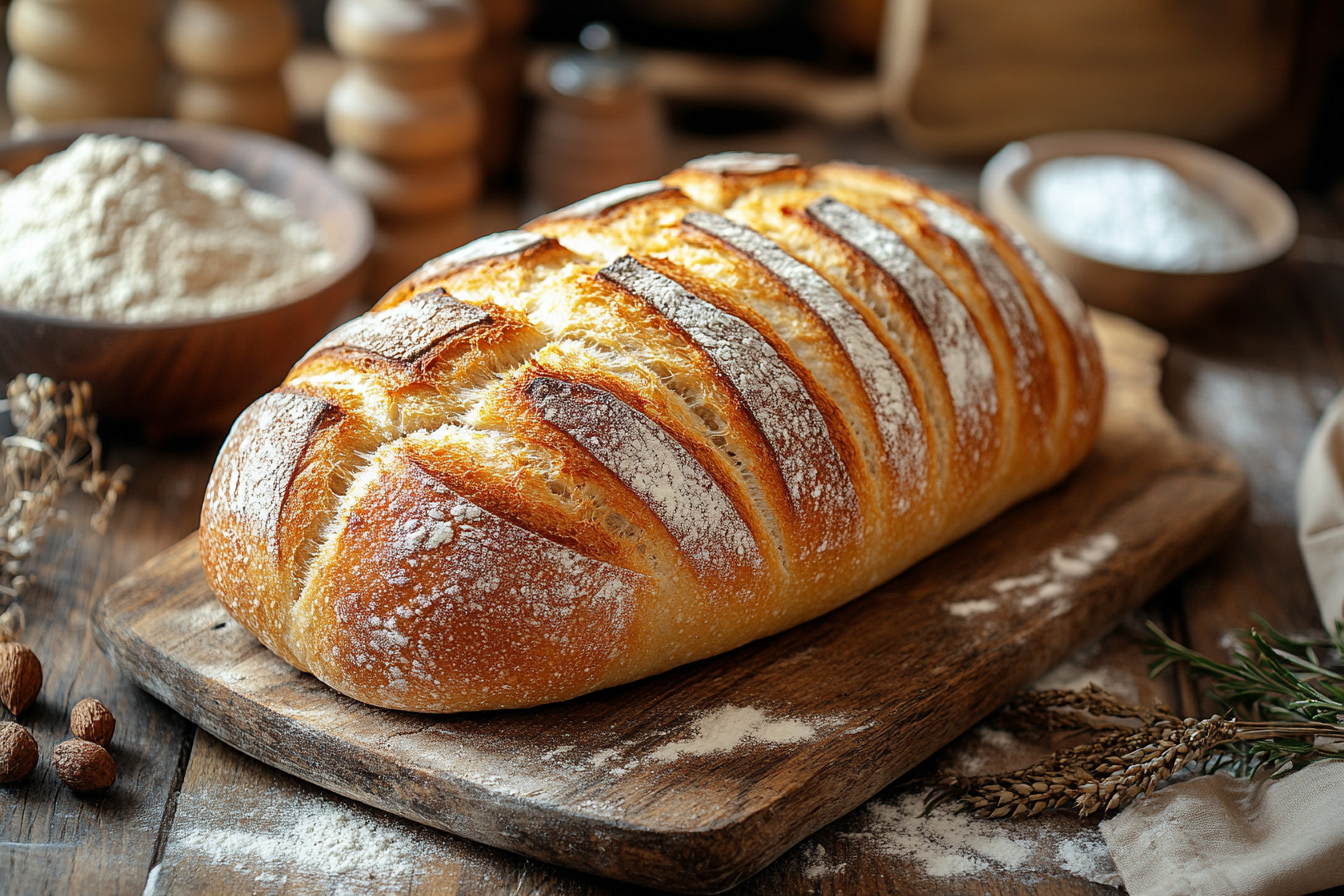Introduction
There’s something undeniably magical about artisan Italian bread. The rich aroma, the perfectly crisp crust, and the airy, tender crumb make it a staple in Italian cuisine. But what truly defines artisan bread? And how does Italian craftsmanship elevate it to something extraordinary?
In this guide, we’ll explore everything about artisan Italian bread, from its origins and traditional ingredients to the step-by-step process of making your own at home. We’ll also cover the most popular types, expert baking tips, and delicious serving suggestions. Whether you’re a seasoned baker or a curious foodie, this article will help you appreciate the artistry behind every loaf.
Now, let’s dive into the world of rustic Italian bread and uncover its secrets!
Table of Contents
1: What Is Artisan Italian Bread?
Defining Artisan Bread
The term artisan bread refers to loaves crafted with time-honored techniques, minimal ingredients, and no artificial preservatives. Unlike mass-produced bread, which is loaded with additives, artisan bread is made using simple, high-quality components like flour, water, yeast, and salt.
So, what makes artisan Italian bread special? It’s all about tradition. Italian bakers have perfected their techniques over centuries, emphasizing natural fermentation, slow proofing, and hand-shaped loaves. This process results in a chewy texture, a golden-brown crust, and deep, complex flavors.
The Uniqueness of Italian Artisan Bread
Italian artisan bread differs from other European styles, such as French baguettes or German rye bread. While the French favor a light and crisp crust, rustic Italian bread is often more open-crumbed, slightly chewy, and deeply flavorful.
Many Italian loaves also rely on biga or poolish (pre-ferments) to enhance texture and taste. These natural fermentation starters give the bread a subtle tang and a longer shelf life without preservatives. Plus, each region in Italy has its own signature style—from the airy ciabatta to the dense, salt-free pane toscano.
Traditional vs. Modern Variations
While traditional Italian bread uses time-intensive methods, modern home bakers have found ways to simplify the process. Some recipes incorporate no-knead techniques, making it easier for beginners to create homemade Italian bread with minimal effort.
However, whether traditional or modern, one thing remains constant: the love and patience that go into every loaf. Authentic artisan Italian bread isn’t just food—it’s a symbol of Italian heritage and passion for quality.
2: A Brief History of Italian Breadmaking
Origins of Italian Bread
The history of artisan Italian bread dates back thousands of years, with its roots in Ancient Rome and Etruscan civilizations. Early Italian bread was made using simple ingredients like ground wheat, water, and natural yeasts. The Romans perfected the art of baking, even building public bakeries to supply fresh loaves to citizens.
By the Middle Ages, regional variations of bread had developed across Italy. Areas with abundant olive groves favored focaccia, while Tuscany became known for its unique pane toscano, a salt-free bread designed to pair with the region’s bold flavors. Over time, these traditional recipes were passed down, preserving the authenticity of Italian artisan bread.
Regional Bread Varieties Across Italy
Italy’s diverse geography has led to a wide variety of bread styles, each reflecting local ingredients and culinary traditions. Some of the most beloved types include:
- Ciabatta – A light, airy bread with a chewy crust, originating in the Veneto region.
- Pane di Altamura – A durum wheat bread from Puglia with a thick, crunchy crust.
- Focaccia – A flat, olive-oil-infused bread popular in Liguria.
- Filone – A long, baguette-like bread found in central Italy.
Cultural Significance in Italian Cuisine
Bread isn’t just food in Italy—it’s a symbol of tradition, hospitality, and community. Families gather around the table to break bread together, often pairing it with local cheeses, cured meats, and fresh olive oil. The art of making artisan Italian bread has been preserved for generations, ensuring that every bite carries a taste of Italy’s rich culinary heritage.
3: Key Ingredients and Their Role
Flour: The Foundation of Artisan Bread
Flour is the backbone of artisan Italian bread, and choosing the right type is crucial. Italian bakers traditionally use:
- Tipo 00 Flour – Ultra-fine and silky, best for soft-textured bread.
- Tipo 0 Flour – Slightly coarser but still delicate, often used for focaccia.
- Semolina Flour – Made from durum wheat, giving bread a rustic, golden crust.
For a truly authentic taste, many bakers blend different flours to achieve the perfect balance of texture and flavor.
Yeast and Fermentation for Perfect Texture
Fermentation is what gives rustic Italian bread its characteristic airy crumb and deep flavor. Many traditional recipes use biga or poolish, which are pre-ferments that develop over time to enhance the dough’s elasticity.
Using wild yeast or sourdough starters instead of commercial yeast creates a complex flavor profile. The slow fermentation process allows the dough to develop naturally, resulting in a more digestible and flavorful loaf.
Water and Salt: Simple Yet Crucial Elements
Water quality plays a significant role in breadmaking. The mineral content affects gluten development, impacting the dough’s structure. Many Italian bakers swear by using spring or filtered water to ensure consistency.
Salt, on the other hand, enhances the bread’s flavor and strengthens gluten. However, in Tuscany, pane toscano is made without salt, a tradition that dates back to a historical salt tax imposed by Pisa. This results in a mild, slightly sweet bread that pairs perfectly with savory dishes.
4: How to Make Artisan Italian Bread at Home

Step-by-Step Recipe with Ingredients
Making artisan Italian bread at home is easier than you think! With simple ingredients and a little patience, you can create a crispy, golden loaf with a soft and airy interior.
Ingredients:
- 3 ½ cups Tipo 00 or bread flour
- 1 ½ cups warm water
- 1 teaspoon salt
- 1 teaspoon sugar
- 1 packet (2 ¼ teaspoons) active dry yeast
- 1 tablespoon olive oil
Instructions:
- Activate the yeast: In a small bowl, mix warm water, sugar, and yeast. Let it sit for 5-10 minutes until it foams.
- Mix the dough: In a large bowl, combine flour and salt. Gradually add the yeast mixture and olive oil. Mix until a shaggy dough forms.
- Knead: Transfer to a floured surface and knead for 8-10 minutes until smooth.
- First rise: Place the dough in an oiled bowl, cover, and let it rise in a warm place for 1-2 hours or until doubled.
- Shape the dough: Gently deflate and shape into a loaf or round boule.
- Second rise: Let it rest for another 30-40 minutes.
- Bake: Preheat the oven to 450°F (230°C). Place the dough on a baking sheet, make a few slashes on top, and bake for 25-30 minutes until golden brown.
- Cool and serve: Let it cool on a wire rack before slicing.
Kneading, Proofing, and Baking Techniques
Kneading is key to developing gluten, which gives artisan Italian bread its chewy texture. If kneading by hand, use the stretch and fold method to strengthen the dough.
For proofing, let the dough rise slowly and naturally. If possible, refrigerate it overnight to enhance flavor. When baking, using a pizza stone or Dutch oven helps create the perfect crust. A bowl of water in the oven will add steam, resulting in a beautifully crispy exterior.
Secrets for Achieving the Perfect Crust
- Use high-heat baking for a crispier crust.
- Brush the loaf with water before baking for extra crunch.
- Bake with steam to achieve an artisan-style finish.
With these tips, you’ll bake artisan Italian bread like a pro!
If you love baking, don’t miss our banana bread cinnamon rolls recipe for another delicious homemade bread treat!
5: Popular Types of Italian Artisan Bread

Ciabatta: The Classic Rustic Loaf
One of the most famous types of artisan Italian bread, ciabatta originated in the Veneto region in the 1980s. With its open crumb structure and crisp crust, it’s perfect for sandwiches, bruschetta, and dipping into olive oil. Unlike traditional loaves, ciabatta uses a wet dough, resulting in its signature airy texture.
Focaccia: Soft, Flavorful, and Versatile
Focaccia is Italy’s answer to flatbread, often topped with olive oil, sea salt, and rosemary. This soft and chewy bread can be enjoyed as a snack, a side dish, or even as the base for a sandwich.
Key features of focaccia:
- Uses high hydration dough for a pillowy texture.
- Can be savory or sweet (try it with caramelized onions or honey!).
- Baked with olive oil for richness and moisture.
Pane Toscano: The Saltless Tuscan Bread
Unlike most breads, pane toscano is made without salt, giving it a mild and slightly sweet flavor. This bread is often paired with bold-flavored dishes, such as cured meats, pecorino cheese, or thick vegetable soups.
The lack of salt in pane toscano dates back to medieval times when Pisa imposed a high tax on salt, forcing Tuscans to bake without it. Despite this, the bread remains a beloved staple in Tuscany today.
Filone: Italy’s Take on the Baguette
Filone is Italy’s version of the French baguette, featuring a crusty exterior and light, fluffy crumb. It’s ideal for making panini, crostini, or simply enjoying with butter and jam.
What makes filone unique?
- Uses biga (pre-ferment) for enhanced flavor.
- Has a long, slender shape, making it great for slicing.
- Offers a chewy yet light texture.
Each of these artisan Italian breads has its own personality, but they all share the same dedication to tradition and craftsmanship. Whether you prefer crispy ciabatta, soft focaccia, or rustic pane toscano, there’s an Italian bread for every occasion!
6: Pairing and Serving Suggestions

Best Ways to Enjoy Artisan Italian Bread
There’s nothing quite like the warm, comforting taste of artisan Italian bread. Whether you’re indulging in a freshly baked loaf or savoring leftovers, there are countless ways to enjoy it.
One of the simplest yet most delicious ways is dipping it in high-quality extra virgin olive oil. A sprinkle of sea salt, fresh herbs, or even balsamic vinegar elevates the flavor. You can also toast slices for bruschetta, topping them with tomatoes, basil, and garlic for a classic Italian appetizer.
For a heartier meal, use rustic Italian bread to make Panzanella, a traditional Tuscan bread salad. Stale bread soaks up the vibrant flavors of ripe tomatoes, onions, basil, and olive oil, creating a dish that bursts with freshness.
Pairing with Olive Oil, Cheese, and Wines
Pairing artisan Italian bread with the right ingredients can enhance its flavor and texture. Here are some excellent combinations:
- Olive oil – Choose a bold, peppery oil for dipping or drizzling.
- Cheese – Try it with creamy burrata, aged Parmigiano-Reggiano, or fresh mozzarella.
- Cured meats – Prosciutto, salami, or mortadella bring out the richness of the bread.
- Wine – Pair with a Chianti for rustic breads, a Prosecco for focaccia, or a full-bodied Barolo for a hearty loaf.
Perfect for Sandwiches, Bruschetta, and More
Because of its versatile texture and flavor, artisan Italian bread makes the perfect base for sandwiches. Try a classic panino with cured meats and cheese, or go for a vegetarian option with roasted vegetables and pesto.
For breakfast, toast a slice and spread it with ricotta and honey, or simply enjoy it with butter and jam. No matter how you serve it, this bread brings a taste of Italy to every meal.
Looking for a sweet treat? Pair your artisan Italian bread with homemade spreads or check out our banana bread cinnamon rolls for a delightful dessert!
7: Common Mistakes and Troubleshooting Tips
Avoiding Dense or Gummy Texture
One of the most common mistakes when making artisan Italian bread is ending up with a dense or gummy crumb. This usually happens due to:
- Not kneading the dough enough – Proper gluten development is key for a light and airy texture.
- Too much flour – Always measure carefully and avoid adding excessive flour while kneading.
- Underproofing – Let the dough rise fully before baking to ensure a soft crumb.
If your bread turns out too dense, try increasing the hydration level slightly or allowing the dough to proof longer.
How to Achieve the Right Fermentation
Fermentation plays a crucial role in developing flavor and structure. To get it right:
- Use biga or poolish for added complexity.
- Let the dough rise slowly at room temperature for better gluten formation.
- Avoid overproofing—if the dough collapses, it has risen too long.
Preventing a Too-Hard or Too-Soft Crust
The perfect artisan Italian bread has a crisp, golden crust. If yours turns out too soft, try these fixes:
- Bake at a higher temperature to get better caramelization.
- Use steam in the oven by placing a bowl of water on the lower rack.
- Let the bread cool properly before slicing to maintain the structure.
With these troubleshooting tips, you’ll be on your way to baking perfect, rustic Italian loaves every time!
8: Frequently Asked Questions
What makes Italian artisan bread different from regular bread?
Artisan Italian bread is crafted using traditional techniques, natural fermentation, and high-quality ingredients. Unlike commercial bread, it contains no preservatives or artificial additives. The result is a crispy crust, chewy interior, and deep flavor that mass-produced loaves simply can’t match.
Can I make artisan Italian bread without a bread machine?
Absolutely! Traditional Italian bread is meant to be made by hand. All you need is flour, water, yeast, and salt. Kneading the dough by hand allows for better gluten development, giving the bread its characteristic texture. A Dutch oven or pizza stone can also help achieve a bakery-style crust.
How do I store artisan Italian bread to keep it fresh?
To maintain freshness, store artisan Italian bread in a paper bag or wrapped in a clean kitchen towel at room temperature. Avoid plastic bags, as they trap moisture and soften the crust. If you need to store it longer, freeze it in an airtight bag and reheat in the oven before serving.
Why does traditional Pane Toscano not contain salt?
Pane Toscano, a Tuscan specialty, is famously made without salt. This tradition dates back to medieval times when a high salt tax led bakers to omit it from their bread. The result is a mild, slightly sweet loaf that pairs perfectly with salty meats and cheeses.
9: Conclusion
Artisan Italian bread is more than just a staple in Italian cuisine—it’s a symbol of tradition, craftsmanship, and passion for high-quality ingredients. Whether you prefer the crispy crust of ciabatta, the soft texture of focaccia, or the rustic charm of pane toscano, every loaf tells a story of centuries-old baking techniques.
Now that you know how to make, serve, and troubleshoot artisan Italian bread, it’s time to try it yourself! With just a few simple ingredients and a little patience, you can bring a taste of Italy into your home.
So, whether you’re dipping a warm slice into olive oil or making a delicious panino, savor every bite of this timeless, homemade bread. Buon appetito! 🍞🇮🇹

